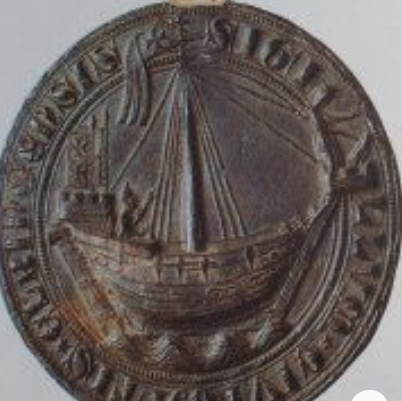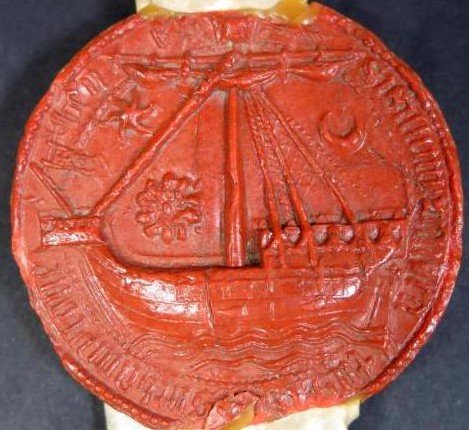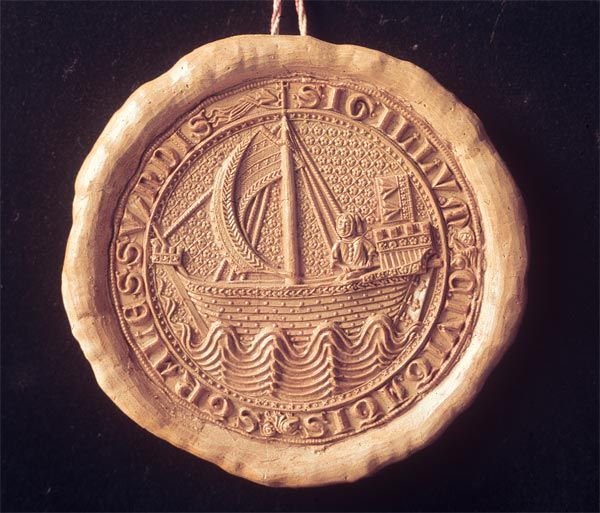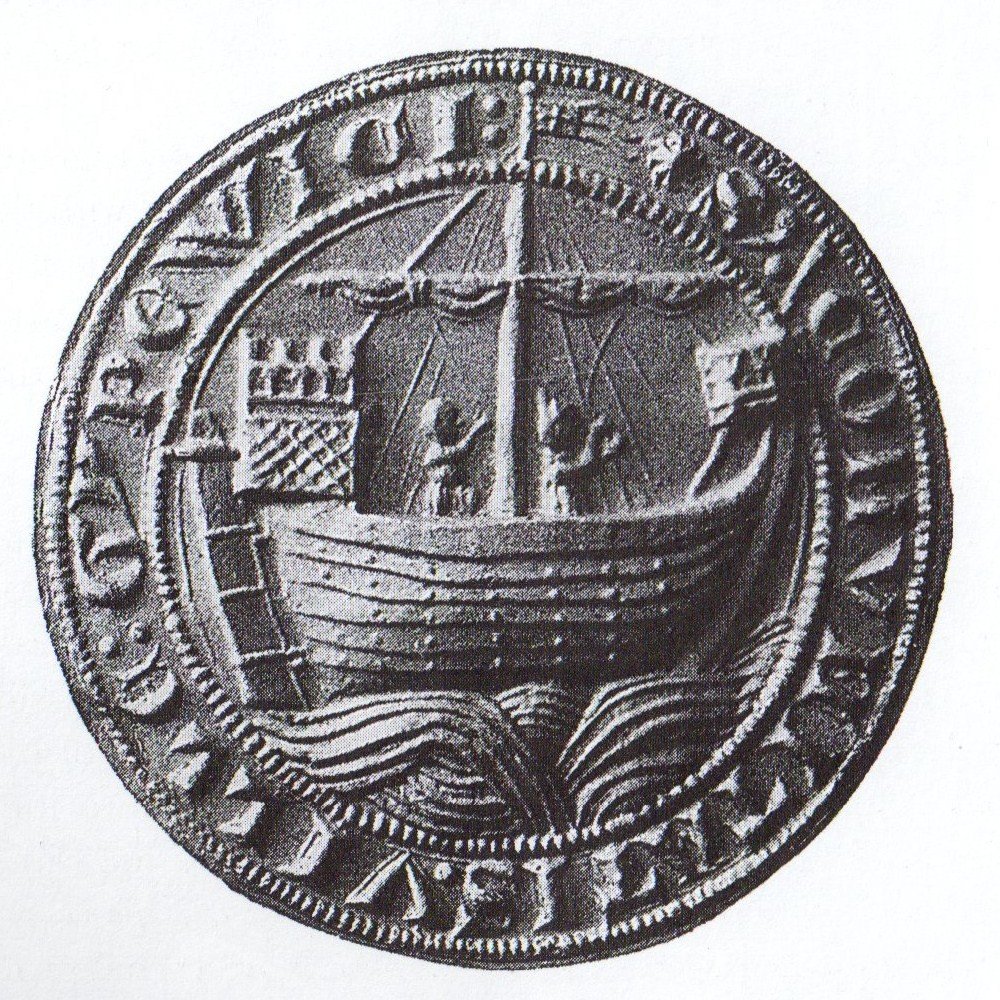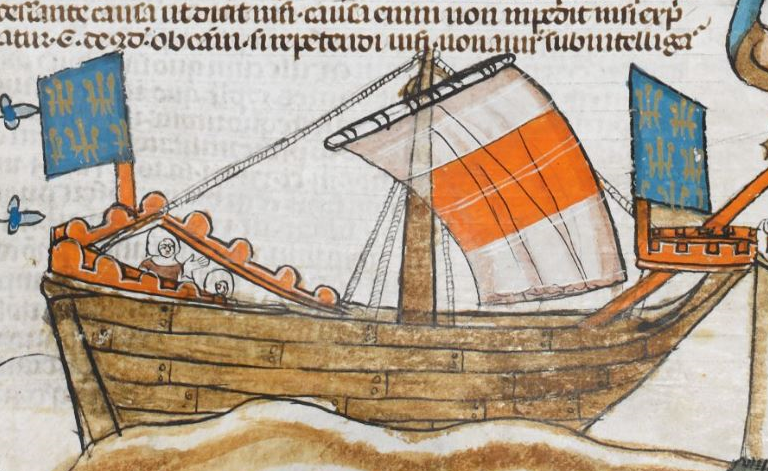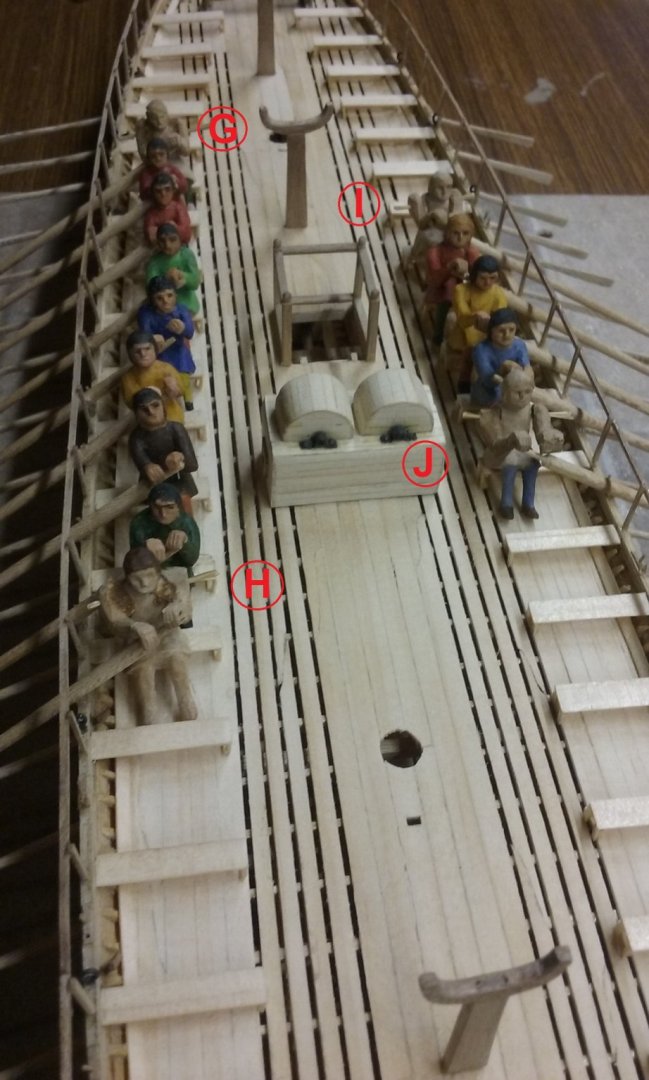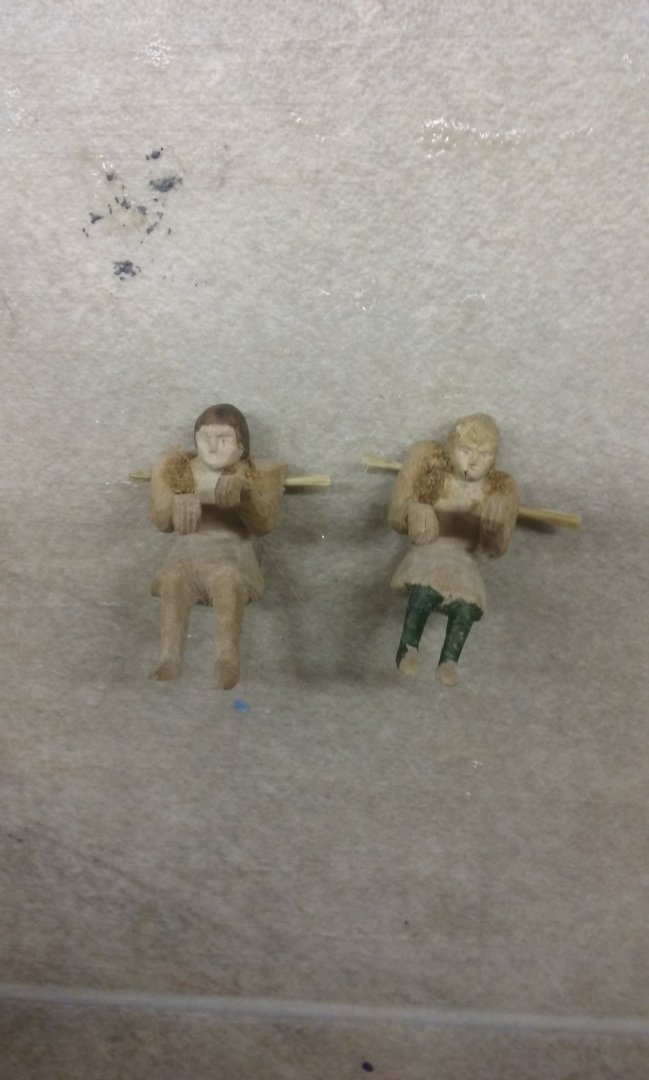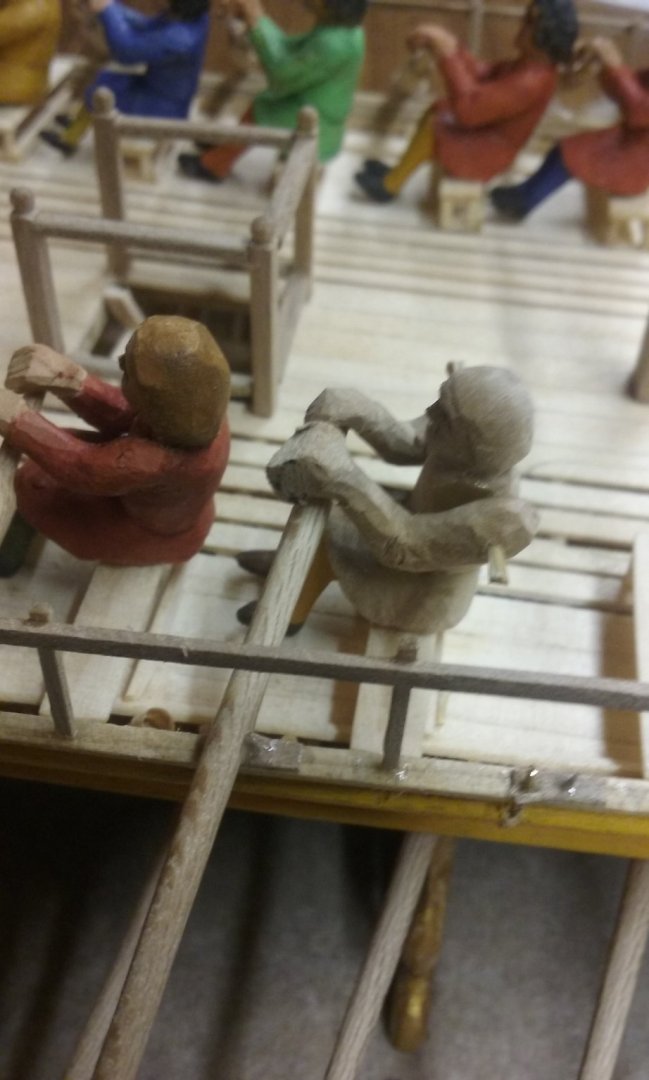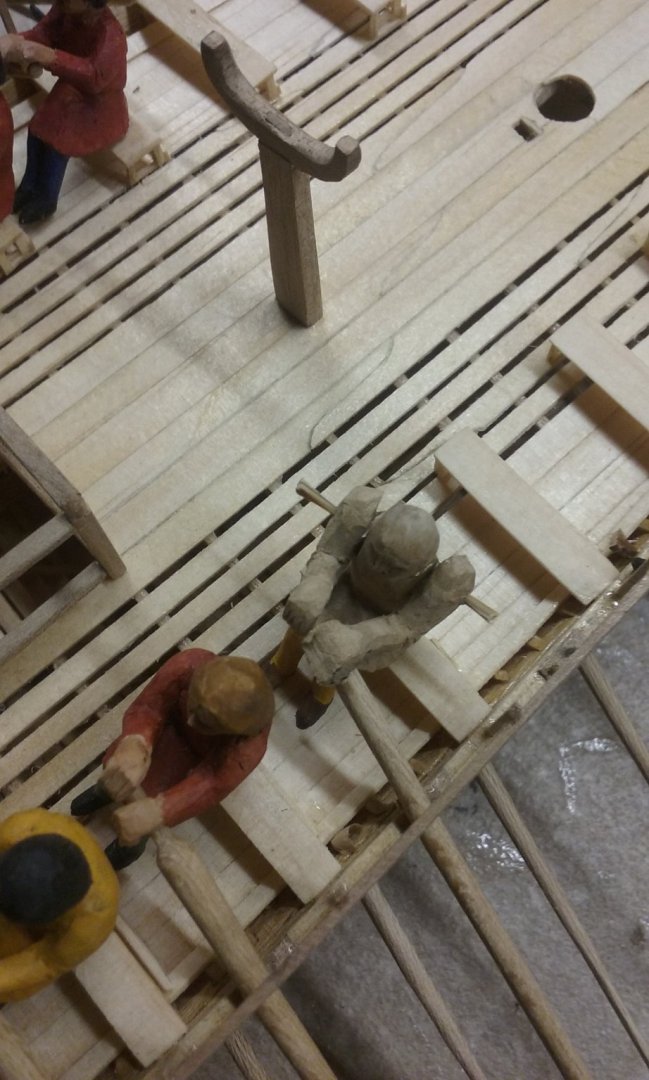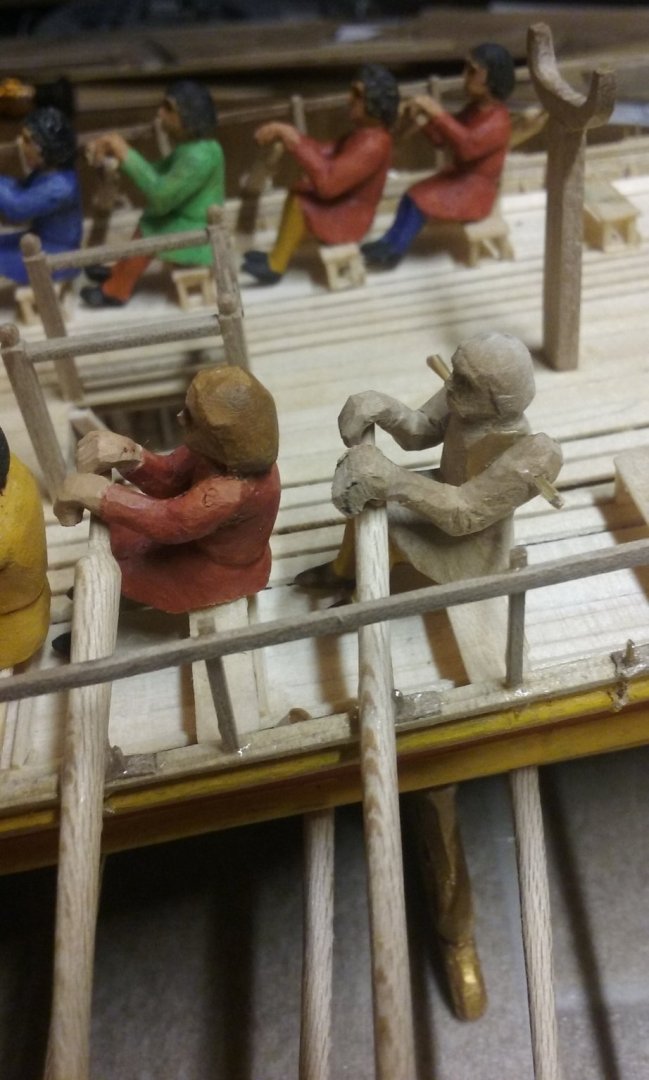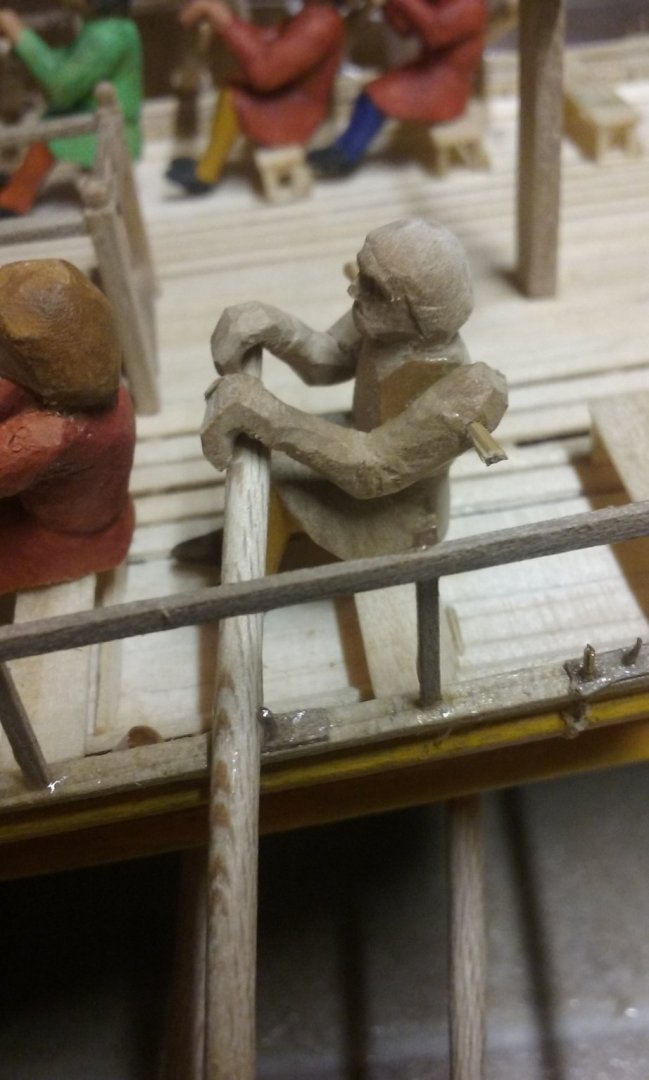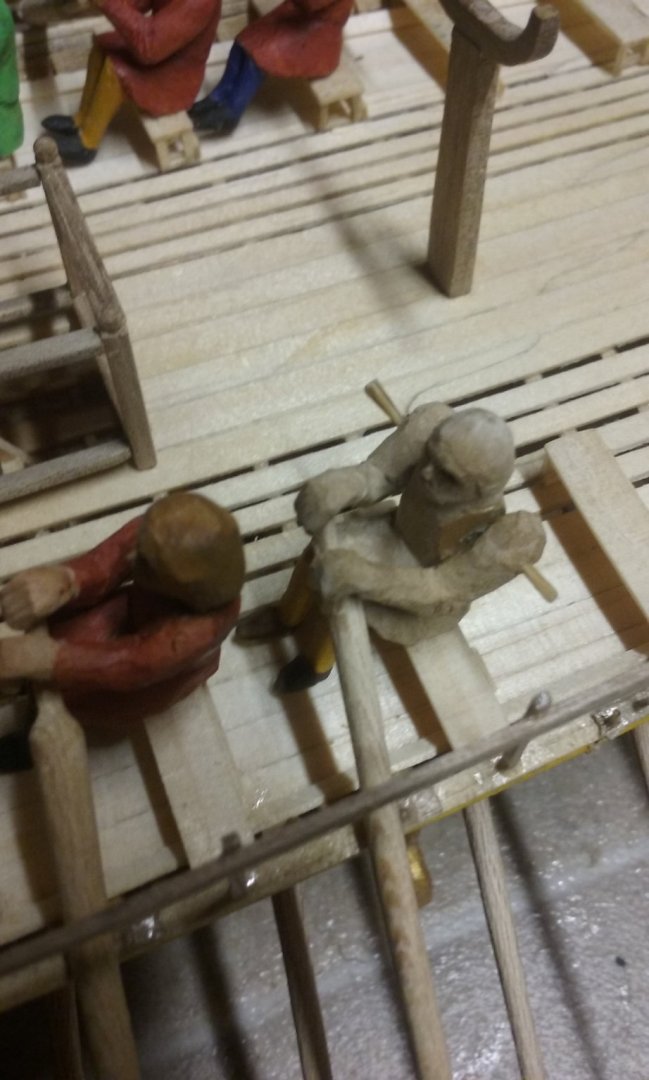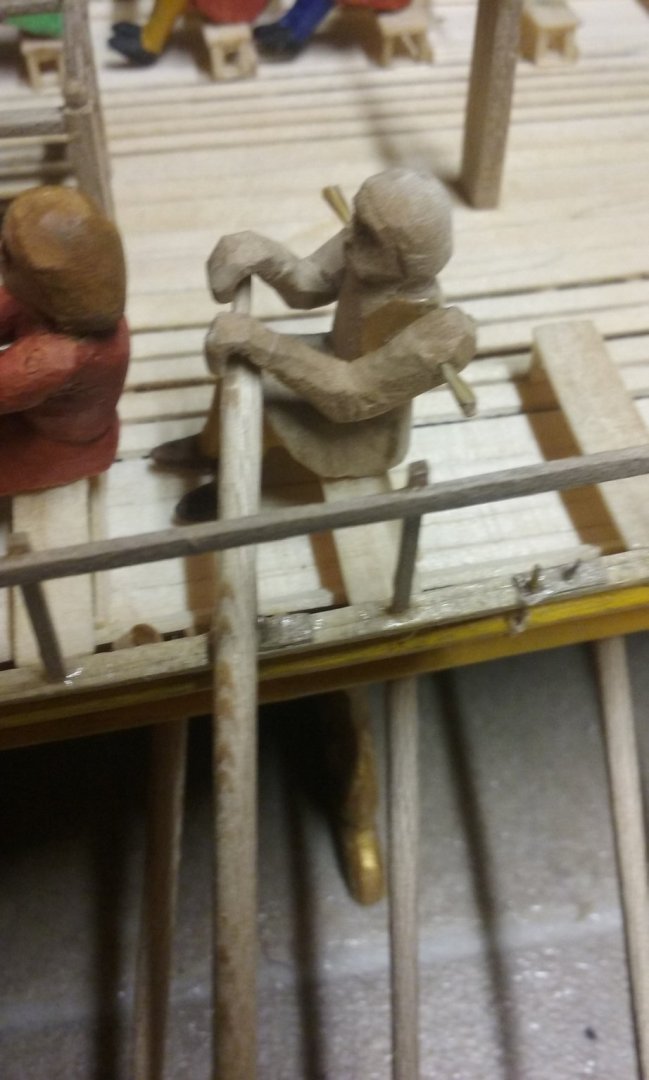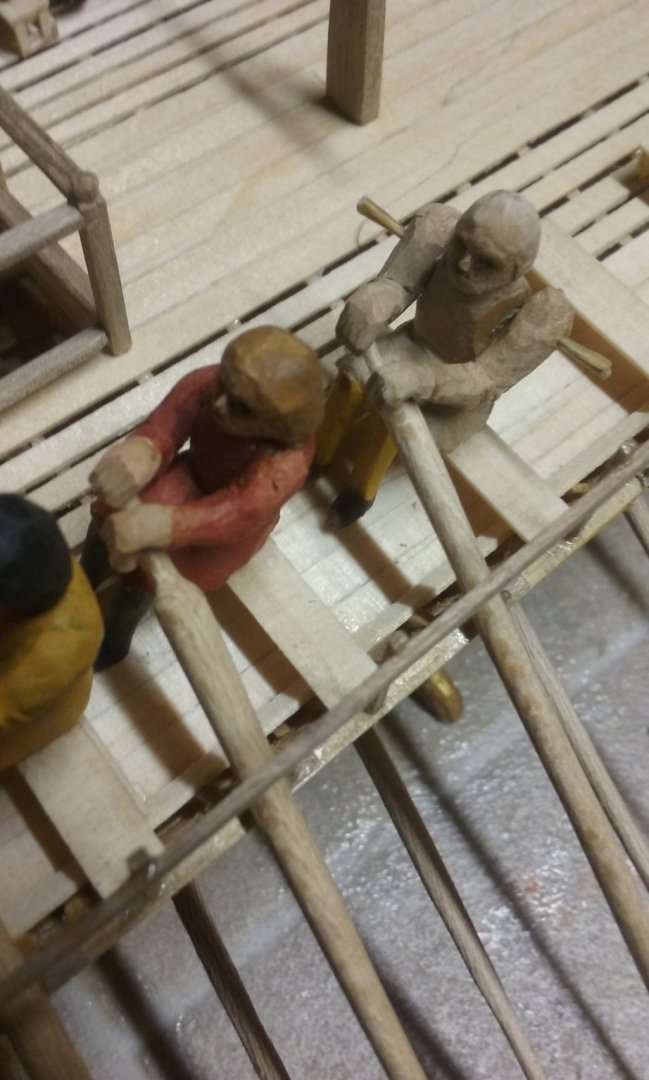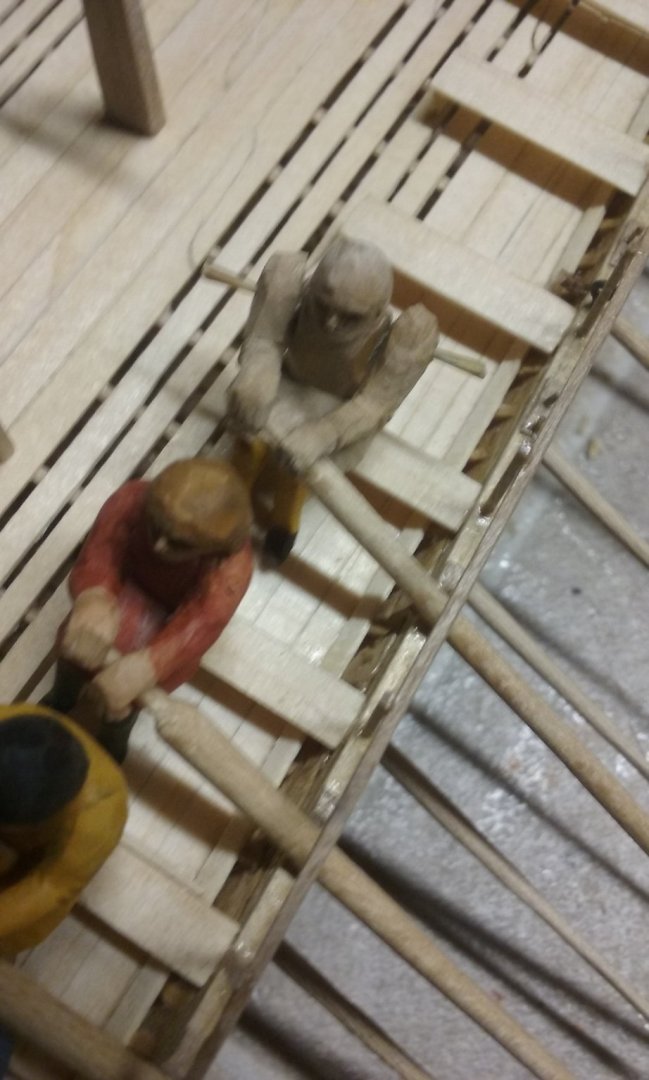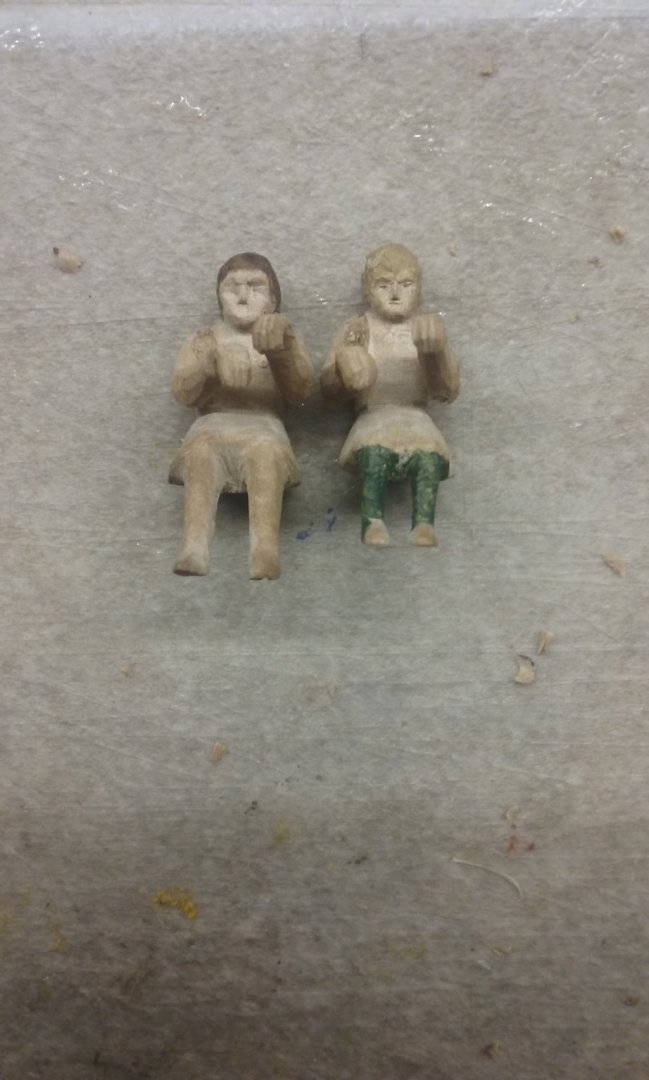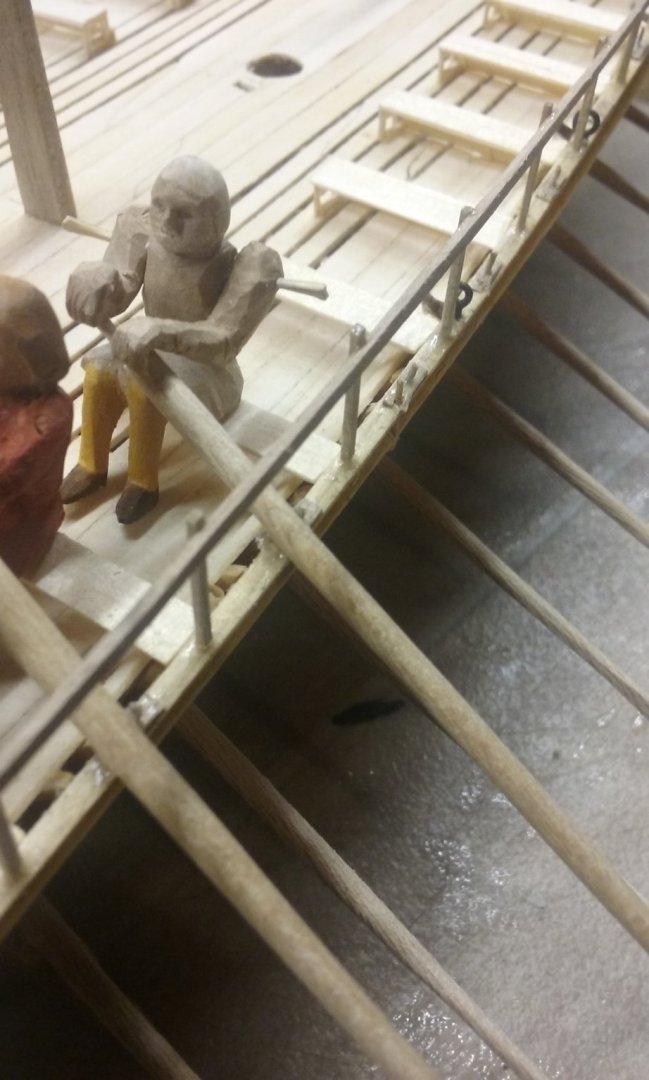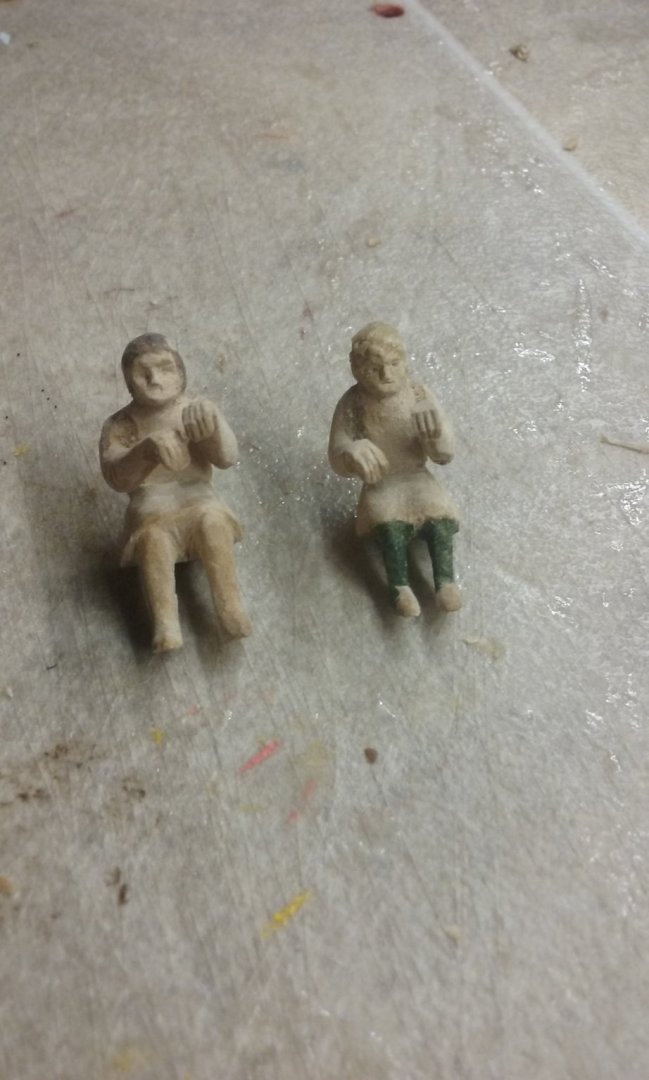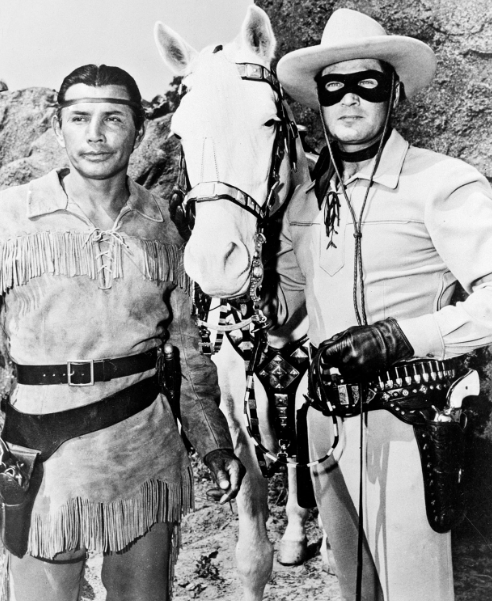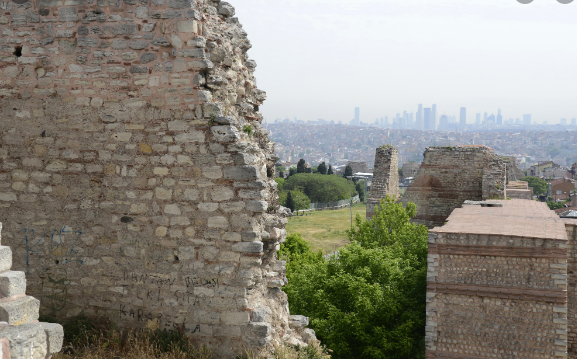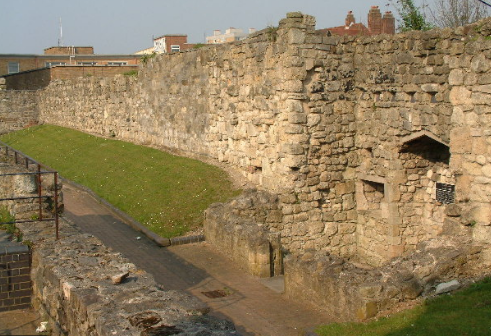-
Posts
7,987 -
Joined
-
Last visited
Content Type
Profiles
Forums
Gallery
Events
Everything posted by Louie da fly
-
I was wondering what they might have done about it. As far as I know this isn't something that has received a lot of attention, but there's been very little information available. in most images of cogs which show the shrouds (unless the fixings are just left off by the artist) they seem to end inboard, such as in the ones below: 1329 Seal of Stralsund Seal of Ipswich - the date given is 1200, but I find that hard to believe. Royal MS 10 E IV Folio 208v c 1300-1340 A 15th-century illustration from Marco Polo’s Travels, held by the Bodleian Library, Oxford, However, the seals below seem to show something like what's provided in the kit. The first two are the seal of Elbing in Germany, at different magnifications. The third is the seal of Southampton, early 15th century. The whole subject of cogs is very interesting - it's just a shame that so little information is available about such things as the rig, and we are reduced to "best guess". It looks to me as though the solution provided in the kit is as good as we're ever likely to have unless another cog is found, but with the rigging intact. We can only hope.
- 179 replies
-
- shipyard
- wütender hund
-
(and 1 more)
Tagged with:
-
Not up till now, and I certainly wouldn't do it commercially, though I have occasionally done carvings for other people as gifts "just because". I see you're doing a Bf 109G-6. Is that why you asked? If so, PM me. Thanks everybody for the likes, and thanks Druxey for the comment. Mark, I expect that would be the case, though as Byzantine oarsmen seem always to have not been barechested, clothes would hide some of that. I've taken that into account to some degree, but it's been a bit of a judgment call - somewhere between He-Man and a 96 pound weakling. But to see the effect of being a galley oarsman, rather than Ben Hur, look at Carry on Cleo. Unfortunately, the rowing scenes aren't available on Youtube (I looked).
-

Sea Witch 1846 by Zooker - RESTORATION
Louie da fly replied to Zooker's topic in - Build logs for subjects built 1801 - 1850
Hi Zooker, The instructions for starting a (scratch-built - which is the most appropriate category to what you're doing) build log are here To move your text and photos, probably the easiest thing to do would be to just write a bit of appropriate text to introduce the subject plus re-upload (or copy and paste) the photos you've included so far. And then go on from there as you make progress in your restoration. And ask lots of questions if you need help or advice - there is no such thing as a stupid question! Yes the book you've been recommended to read relates to the rigging of real ships. It's then up to you how accurately you wish to copy that rigging, bearing in mind the practicalities of making everything much smaller. The smaller the scale of the build, the simpler most people make everything - it's often better to leave out a lot of the fiddly bits at a small scale because (a) they're hard to make and (b) sometimes they actually detract from the overall impression you're trying to achieve. It's your decision, your model. As you're restoring an existing model, it's probably best to try to get it back to the way it was originally built, using the book as a guide in case of doubt. And there's a whole section in the forum on "Masting, Rigging and Sails" - good for seeing how others have done it, and for getting your own specific questions answered by those "in the know". Good luck with it, and have fun! (which is why we do this, after all). -
Hi Daryl, You might like to look at this, it gives a good rundown on models suitable for beginners. Just be aware that unfortunately Artesania Latina is no longer in business, though apparently there are still AL models out there if you're prepared to look. Start a build log when you do begin your build. It's a great way to get help and advice (and encouragement!). And it would be nice to see some photos of your dory.
-
Just out of interest, Chris, what does the kit have in the way of fixings for the lower end of the shrouds? I've just been looking at this in relation to another "cog" build at Rather interesting. It appears deadeyes didn't evolve until sometime in the 15th century.
- 179 replies
-
- shipyard
- wütender hund
-
(and 1 more)
Tagged with:
-
Good to see you under way on your build, Nelson. There are a lot of Viking ships among the build logs - and not just kits; there are some amazing scratch builds as well. Before planking, read everything you can in the build logs. And perhaps do some practice planking before you commit yourself to doing it on the model itself. Clinker is fairly difficult, especially with planking following the curved stem and stern posts. Good luck with it, and have fun!
-
Hi Kim, The instructions for starting a build log for a kit are here: Looking forward to seeing yours for your pinnace. By the amount of experience you've had, it should be a pleasurable log to follow.
-
More work on the oarsmen. Two new guys added (figures I and J), and figures G and H have had their hands carved to shape to fit the oar handles and arms glued in place. Here's the process I use to get the hand to fit the handle (Figure I - left hand - the right is already done). Rough cut: the hand is just a squarish block of wood - at this stage I work out where I have to carve the hollow the oar handle will fit into. Note the arm is pivoted on a friction-fitted bamboo pin at the shoulder, which allows me to remove the arm to work on it and also to swivel it down into its final place when I've finished shaping it. Next, after taking the arm off, carving the hollow and replacing the arm. Then doing it again to get it closer still to the the shape I need: A bit of shaping of the hand itself: More shaping of both hand and arm, and cutting a demarkation line at the cuff between sleeve and hand And adding grooves to show the fingers. Not a perfect work of art I'm afraid, but they do the job well enough (and I'm making a ship model - the figures are just for atmosphere). And here are Figures G and H with their arms swivelled into place and glued in position. I've put wood filler in the gaps between arm and body. Note the enormous shoulders (and upper arms) which are then trimmed to shape once the glue and filler have dried properly. And here they are sanded and ready for painting.
-

Hello from the San Francisco Bay Area
Louie da fly replied to ChuckJ's topic in New member Introductions
ChuckJ, I would recommend you restore this model. The more I look at it the more I like it. It'll take quite a bit of work, and it's not perfectly historically accurate, but it has the sweetest lines and would amply repay the work you put into it. And if you do, make sure you start a build log for it. There are quite a number of "restoration" builds going on at the moment (I'm doing one myself!) and if you type "restoration"into the search bar at the top, and then click on the tag "restoration" (you could also try the word "restoring") you'll get all the builds of that type, which should give you a good idea of the things you'll need to do to return this beauty to her original glory. By the way, I would disagree that she's the Ark Royal in particular - I think she's meant to be just a "generic" late Elizabethan galleon. -
Welcome, Kimosubby. I like the name - visions of the Lone Ranger sprang immediately to mind . . . Any chance of some photos of your builds? And perhaps you could start a build log for your armed pinnace.
-
I've put this build on hold for the time being - I'm putting all my efforts into the dromon build at the moment, trying to get all the oarsmen completed. Once that's done I'll be able to do some more on the Great Harry.
- 740 replies
-
- Tudor
- restoration
-
(and 4 more)
Tagged with:
-

Matthias from Berlin, Germany says Hello
Louie da fly replied to victory78's topic in New member Introductions
Nice work. I can see you used the technique "cut away everything that doesn't look like the captain" -
Yes, quite an attractive model, too. If you want to see the best research I've seen on Elizabethan period galleons, hie thee to Backer's Pelican/Golden Hind build at
-
Very appropriate! If the building had been repaired at any time you'd find all kinds of bodgy work. Having seen quite a few mediaeval stone walls, many of them had pretty rough stonework. This photo is of the Land Walls of Constantinople (modern Istanbul). The tidy stuff at the right is a modern reconstructed wall. And below is a section of wall at Southampton, UK.
-
Hi Jonathan, I'd say the main concern with those pieces you've glued at right angles at the bow is that the grain is running at right angles to the grain of the planks and it will show, particularly if you're planning to stain rather than paint. I don't understand why these planks are so much shorter than they should be, but you might be best re-doing. If you do, I'd suggest you keep those two planks either side in position but cut them considerably shorter and offset their ends to suggest that they end at different frames, as was done in planking on real ships of the time (full size planks were normally about 20 feet long, but the ends were offset so they didn't all have joins at the same frame - there's a good photo of this at What kind of glue are you using? PVA (white) glue can be dissolved using isopropyl alcohol (isopropanol, commonly known as rubbing alcohol), and I'v been told (though I haven't tried it myself) that nail polish remover will dissolve CA (superglue). Other than that, your planking looks good. From your photo it looks like though you followed the kit's instructions for your first planking (with that sudden transition near the bow between the planking below and above the waterline), but you're doing the second layer of planking as was done on real ships (as in the photo in the link above). Well done, sir! Overall, going well. Keep it up - you're going to ed up with a model to be proud of.
-
Hey, Bensid - did you ever finish Charon? The log seems to have just come to a sudden halt about two and a half years ago. I lost trace of it, but I was looking forward to seeing it complete. Now that the buildlogs have been re-organised it was visible again. It would be really good to get an update - particularly if there's a video available
-
Ah, I hadn't realised they were part of the kit. In this case, it looks like the route you're taking is the best possible. It's just a shame they didn't use cotton thread.
- 195 replies
-
- lady eleanor
- vanguard models
-
(and 1 more)
Tagged with:
-
Not a problem, but if you have any photos of the intermediate steps between the completed hull and the previous post, that would be great. She looks very good.
-
Hi PJ. Have a look at the second-last page of my dromon build log (the link is in my signature below). All the carved crewmen are made of pear wood. The colour values might not be perfect, but you can get some idea from the post of June 25. The oarbenches are made of radiata pine (thanks, Bunnings!), so though the oarsmen are a little darker they are certainly not red or grey. There is a certain amount of colour variation between different bits of wood, but generally that colour is pretty reliable. Now if you can just find someone with a pear tree . . .
-
Hi Miguel, Perhaps the best thing you can do is start a new thread in "Discussions for Ships' Plans and Project Research. General Research on Specific vessels and Ship Types", asking if anyone can help provide plans for your model. Perhaps someone has already made this model and still has the plans, and can supply them to you. Good luck with it.
-
As someone already addicted (and currently doing a restoration of a ship I made when I was a teenager) , every time I see one of these I think to myself "A bit of cleaning, some repair - that could look pretty damn good". I find restoring a model very rewarding -changing it from something dirty and damaged to something worthwhile. Start a buildlog and show us what you're doing - it'll give other members the opportunity to give help,advice and guidance on your journey of restoration. If after you've finished you find yourself addicted - well you're not alone
About us
Modelshipworld - Advancing Ship Modeling through Research
SSL Secured
Your security is important for us so this Website is SSL-Secured
NRG Mailing Address
Nautical Research Guild
237 South Lincoln Street
Westmont IL, 60559-1917
Model Ship World ® and the MSW logo are Registered Trademarks, and belong to the Nautical Research Guild (United States Patent and Trademark Office: No. 6,929,264 & No. 6,929,274, registered Dec. 20, 2022)
Helpful Links
About the NRG
If you enjoy building ship models that are historically accurate as well as beautiful, then The Nautical Research Guild (NRG) is just right for you.
The Guild is a non-profit educational organization whose mission is to “Advance Ship Modeling Through Research”. We provide support to our members in their efforts to raise the quality of their model ships.
The Nautical Research Guild has published our world-renowned quarterly magazine, The Nautical Research Journal, since 1955. The pages of the Journal are full of articles by accomplished ship modelers who show you how they create those exquisite details on their models, and by maritime historians who show you the correct details to build. The Journal is available in both print and digital editions. Go to the NRG web site (www.thenrg.org) to download a complimentary digital copy of the Journal. The NRG also publishes plan sets, books and compilations of back issues of the Journal and the former Ships in Scale and Model Ship Builder magazines.


